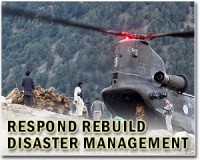| . |  |
. |
Tokyo (AFP) April 9, 2011 Residents of towns surrounding a crippled nuclear plant are regularly returning home, an official said Saturday, defying health warnings as the world's worst nuclear accident since Chernobyl drags on. Others never left, refusing to evacuate from the 20-kilometre (12-mile) zone around Fukushima Daiichi when the power plant began spewing harmful radioactive materials four weeks ago. In Minamisoma city alone, at least 57 people have been inside the zone ever since the plant was severely damaged by the 9.0-magnitude earthquake and tsunami on March 11. "If they say they don't want to leave, we cannot force them," a city official told AFP. "Municipality staff and emergency workers have visited them, but they have refused to leave their homes," said the man, who did not want to be named. The Tokyo Shimbun newspaper said around 100 people were believed to have stayed inside the 20-kilometre zone, with many more travelling from evacuation centres to their homes to collect valuables or personal effects. Evacuation orders are currently issued when residents are at risk of receiving radiation of at least 50 microsieverts per hour. The government does not release figures on radiation levels inside the zone, but footage posted on video sharing site YouTube by journalist Tetsuo Jimbo, who drove and walked through the zone, showed levels as high as 112 microsieverts. At that level a person gets the same amount of radiation every day as they would expect under normal circumstances in a year. The government concedes that its present warning, which does not allow officials to forcibly evacuate people, is only a short term measure. "The standard does not take into account the effects of cumulative exposure," Chief Cabinet Secretary Yukio Edano said this week. "We are discussing what standards to use for cumulative radiation." But fears over the long term effects are not enough to shift some people. One elderly couple has stayed to care for a bedridden relative in her 90s, local media has said. Another elderly man has reportedly refused to leave the house in which his family has lived for generations. A man in his 80s who lives alone in Narahamachi town, 18 kilometres from the plant, told the Mainichi Shimbun he was too old to go anywhere. He has ignored his daughter's pleas to leave, the newspaper said. Edano said Thursday Tokyo was considering upgrading its order to make forceful evacuation possible and to impose an official ban on going into areas around the plant. But he also said the government was mulling ways to let people visit their houses temporarily if they are properly shielded from the radiation and accompanied by officials. That decision is taking too long for many of those who fled the zone, the Minamisoma official said. Those whose homes are within a band of between 20 and 30 kilometres around the plant, where the government says people can stay but should not venture outside, are ignoring the advice. "There are so many of them, we cannot count. You cannot stay indoors forever. People are outside, doing whatever they do," the official said. Minamisoma Mayor Katsunobu Sakurai met with Prime Minister Naoto Kan Friday to ask for help to keep his township together. "We ask you to help us so that residents will return and to allow us to have a functioning local administration," he told Kan. "If the evacuation becomes prolonged, we will lose our sense of community."
Share This Article With Planet Earth
Related Links Bringing Order To A World Of Disasters A world of storm and tempest When the Earth Quakes
 Disabled Japanese struggle in disaster aftermath
Disabled Japanese struggle in disaster aftermathOtsuchi, Japan (AFP) April 9, 2011 Sachiko Miura had no warning before a huge tsunami slammed into the small Japanese fishing village where she has lived all her life - because she could not hear the sirens. The first the hearing-impaired 66-year-old knew of the impending disaster was when she saw the massive wave bearing down on her small wooden house, less than an hour after the worst earthquake in Japan's recorded history ... read more |
|
| The content herein, unless otherwise known to be public domain, are Copyright 1995-2010 - SpaceDaily. AFP and UPI Wire Stories are copyright Agence France-Presse and United Press International. ESA Portal Reports are copyright European Space Agency. All NASA sourced material is public domain. Additional copyrights may apply in whole or part to other bona fide parties. Advertising does not imply endorsement,agreement or approval of any opinions, statements or information provided by SpaceDaily on any Web page published or hosted by SpaceDaily. Privacy Statement |